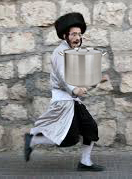Beitza 18b-19a
1- Continuing the discussion concerning the toiveling of keilim on Saabbos and Yom Tov:
In the Beraisa, the Tanna Kamma and Rebbi Shimon Shezuri disagree about whether one may immerse a Keli on a weekday during Bein ha’Shemashos.

The issues:
- Bein ha’Shemashos is a period of time of which we are unsure if it still day, night or both.
- If it is night then Shabbos or Yom Tov have already arrived and the prohibition applies.
- If it is day, the the tevila is permitted but the keli may only be used the following evening since we need
- הערב שמש – “He’erev Shemesh”.
So what is their argument?
When the Rabanan learned the Beraisa, they explained that the argument applies in a case in which a person was running with the Keli towards the Mikvah at Bein ha’Shemashos. He clearly wanted to immerse the Keli before sundown.

The Tanna Kamma says that in such a case one may immerse the Keli during Bein ha’Shemashos on a weekday, since he demonstrates through his actions (by running with the Keli to immerse it before Bein ha’Shemashos) that he knows that the Keli needs “He’erev Shemesh” (sundown) in order to become Tahor for use with תרומה – Terumah.
Rebbi Shimon Shezuri argues and does not permit one to immerse the Keli during Bein ha’Shemashos, because he maintains that the person’s actions do not demonstrate that he knows that “He’erev Shemesh” is required (perhaps he was running in order to get back to his work). So he may toivel the keli and use it immediately.
2- We discussed the version appearing in our Gemara.
“a person was running with the Kli towards the Mikvah at Bein ha’Shemashos.”
The obvious problem is that if it is already
Bein ha’Shemashos then in any case it is too late to toivel to allow the keli to be used that evening.
3- We spoke about the famous Reb Raphael Nathan Nata Rabbinovicz. Here is form the Jewish Encyclopedia

Talmudical scholar and antiquarian; born at Novo-Zhagory, government of Kovno, Russia, in 1835; died at Kiev Nov. 28, 1888. At the age of twenty-eight he left Russia, and, having spent some time in Lemberg, (Lvov) Pressburg, (Bratislava) and Eisenstadt, went to Munich, where he finally settled.
There he found buried in the royal library the famous “Codex Hebraicas.” This manuscript of the Babylonian Talmud was written in 1342 and had the good fortune to escape the hands of the censors. One hundred and fifty years before Rabbinovicz first saw this manuscript its significance had already been pointed out by R. Nathan Weil, the author of the “Ḳorban Netan’el,” but nobody had yet ventured to undertake the immense task of editing it. Rabbinovicz determined to make a critical examination of it. His task was greatly facilitated by the munificence of Abraham Merzbacher, a wealthy antiquarian of Munich, who appropriated a large sum of money for the maintenance of Rabbinovicz while engaged in his work of research, and who put his magnificent library at his disposal.

Rabbinovicz spent six years in study and travel. During this period he visited many libraries in France, Italy, England, and Russia. Everywhere he gathered material for his magnum opus, the “Diḳduḳe Soferim.” In 1868 the first volume, comprising Berakot and Zera’im, was published. It was followed in quick succession by others; fifteen volumes were published by 1888; the sixteenth volume was being prepared for publication when death closed his career.
The “Diḳduḳe Soferim” a work that is indispensable to the student of the Talmud and its antiquities, gave to Rabbinovicz a world-wide reputation. Scholars in every part of Europe, Jewish and non-Jewish, turned to him whenever a disputed point in Talmud needed to be elucidated.
4- Here are some other links.
The book – Dikdukei Sofrim
מאמר הדפסת התלמוד
http://beta.hebrewbooks.org/reader/reader.aspx?sfid=38519http://beta.hebrewbooks.org/reader/reader.aspx?sfid=38519
5- As one can see, in the said manuscript the words at Bein ha’Shemashos are omitted. See his footnote 50.
http://beta.hebrewbooks.org/pdfpager.aspx?req=38513&st=&pgnum=56
6- We finished with Gemara discussing a case where someone toivels keilim that are already tahor in a mikva simply because… he wants the ‘extra’ tahara.

Is that considered toiveling? or just….dipping? 😀

That 2nd picture looks like moonset not sunset.
The end of part 1 ends “So he may toivel the keli and use it immediately”, perhaps it should say “So he might toivel the keli and use it immediately’ (‘may’ sounds like he’s allowed, we are trying to say he ‘might’ do something wrong and therefore it’s NOT allowed.